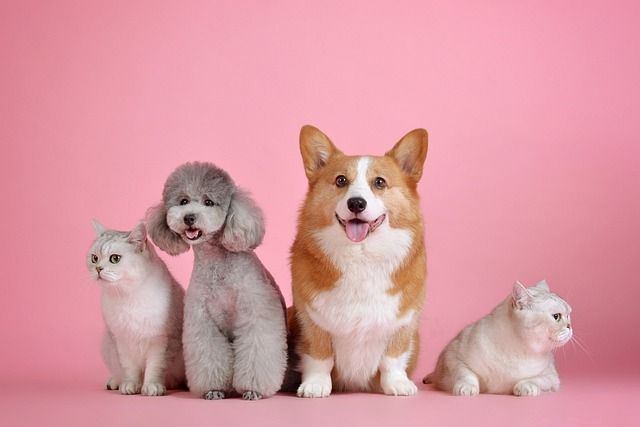Beyond the myth: Here are some key aspects about the dog and the cat
Today, cats and dogs are known as companion animals and, colloquially, as small species. Although they are not the only pets, they are undoubtedly the most numerous and the most widespread.

The man had not yet begun to live his own history, when the dog was already his companion and, why not, his friend. In prehistoric tombs, the bones of dogs have been found next to those of man; of course, not similar to the present ones, with their vaccination medal and their hair well cut and groomed, but this shows their closeness and friendship.
The intelligence and affection that dogs show for their masters are aspects common to all dogs of any era, but this is not the only characteristic that distinguishes them from other animals, since they "have their calling card stamped on them", due to their many aptitudes for work, in addition to their companionship.
If the dog is characterized by its indisputable "friendship" with man, the cat, a fascinating animal, maintains - in my opinion - an ambiguous and indecipherable position. It can be defined indifferently as "the wildest of domestic animals" or as "the most domestic of wild animals". It is true, however, that after so many years of life with us, it still retains a certain distrust or, at least, an aloofness to man, especially if it is allowed to live with a certain amount of freedom.
Origins of the dog and the cat
The origins of the dog are very obscure, very little is known. Its presence has been evident for millions of years. The first fossil canids are found in the tertiary formations, although they do not seem to be the direct ancestors of our current dogs, remembering that among the most evolved animals, the dog is the one with the greatest variety of breeds, due not only to the great evolutionary potential and its remarkable adaptability but also to man's effort to increase them through crossbreeding and selection.
The first theory of origin is that of uniqueness (monophyletic origin), in which an extinct (or still existing) wild ancestor differentiated itself by evolving into today's great variety. No evident and decisive proof supports this hypothesis, but many arguments speak in its favor, such as the comparison with the history of the horse, whose evolution - since the Eocene epoch - starts from a unique type. Another argument that seems valid is the extraordinary variability, its diffusion, and the perfect interbreeding between apparently very different breeds.
The pluralist theory defends multiple origins (polyphyletic origin). In other words, the ancestors would be more than one. Actually, the only point in favor, and rather weak, is the great variety of breeds. The dog could have its origin in the wolf because the crossbreeding between them originates fertile offspring. This theory was discarded because the wolf's jaw is highly developed with that of the dog, in addition to other differences in the skull. These differences may be due to changes due to domestication. If we accept this conclusion, the wolf may be the origin of the large canine breeds.
According to other hypotheses, the origin of the breeds of the old continent may be the jackal (canis aureus), the Indian wolf (canis pallipes), and the Egyptian wolf (canis lupaster).
The wolf, which hides during the day, hunts at night, and flees from man, is one of the most difficult animals to tame, while the jackal partially accepts contact with the man and has even been shown to become attached to him. The similarities between the dog and the jackal seem to be confirmed to some extent so that some researchers believe that the small canine breeds are descended from several species of jackals.
Others have mentioned a possible origin of the dog in the fox. All these are only unconfirmed hypotheses; there are no definitive conclusions. The only thing certain about this species is its adaptation to domestic life since very remote times.
Prehistory
In Danish prehistoric stratifications, dog bones have been found. In some lakeside towns in Switzerland and among remains from the Bronze Age, skulls and bones similar to those of today's dogs have been found. With these sure testimonies, we can imagine that the dog and man lived in a kind of symbiosis, simple commensals, initially feeding on the remains of the hunted animals and warning man of possible dangers; later helping him in the hunt by their olfactory gifts and sharing the food, as well as protecting him during the night, pointing out possible dangers.
In Europe, at the time of the lake towns and stilt houses, two canine breeds were known, one for guarding and the other for shepherds. These seem to have their origin in the Canis familiaris palustris, a fossil considered by many as the only ancestor of European dogs.
As for cats, their origin is no clearer than that of dogs. As already mentioned, the Miacis is the probable ancestor of the cat and the other carnivorous mammals; the descendant of these, the Cynodictis, differentiated into Ailuroides and Machairodontinos during the Pleistocene, and from there to all the present felines. The domestic cat (Felis catus) and the wild cats (Felis silvestris), possibly originated from the cats of Egypt, North Africa, and Continental Europe; in short, the writings on this subject seem more like legends than testimonies.
The two species are currently known as companion animals and, for the veterinary zootechnician, colloquially, as small species. They are not the only pets, but they are undoubtedly the most numerous and the most widespread.
Dogs and cats represent the most common interspecific relationship between humans and animals. Many generations of dogs and cats have lived with a man and have shown physiological and behavioral variations or adaptations. They have also retained other characteristics related to their phylogenetic evolution (the study of the origin and evolution of species and subspecific groups).
Each animal species has its own social structure; in mammals, this is of particular importance. Each one is part of its community, its environment, and the origin of its species; in short, "inheritance, environment, and learning". Hence, in the following section, some characteristics of domestic carnivores will be described.
General information about carnivores
Within the carnivore group, only dogs and cats are considered domestic. They belong to the order of terrestrial carnivores or Fissipeds, to separate them from the Pinnipeds or aquatic carnivores, which for a long time shared the same order. Fissiped carnivores are unguiculate (clawed), free-toed mammals with more or less complete dentition, adapted to a diet of prey (carcasses). Indeed, some, such as bears, are omnivorous and others, such as badgers, are frugivorous.
Dogs and cats are pure carnivores in the wild, converted into omnivores by the influence of domestication and, in addition, let us remember that when they feed on carcasses they also feed on their intestinal contents, generally full of vegetables. Terrestrial carnivores have the same organization but differ greatly in the general shape of the body, coat, dimensions, and structure of their limbs. The best example of these variations are the dog and the cat, which also present notable differences in their physiological makeup. Dogs and cats are the only current domestic carnivores. They belong to the canine and feline families respectively.
General characteristics of canids
Family of medium-sized animals, rarely small. Elongated body, with powerful and elevated limbs. Expressive head, massive, with the skull more or less elongated in its facial portion, and inserted in a prominent neck. Long tail, covered with hair. In the extremities of the limbs, the fingers are in several 5/5, 5/4, or 4/4, with strong and curved nails, not retractile and well defined as digitigrade. The coat is short (rarely long), grayish or yellowish-gray, rarely patterned. The duration of gestation, variable according to the species, is 64 days in the female dog. The number of puppies at birth also varies according to the species, being from 4 to 12 in the female dog. Longevity is 10 to 20 years, in direct relation to size; on average 10 to 12 in the dog.
The habits of wild canids are particular. They generally live in isolation, but may live in pairs and sometimes in large packs. They are excellent hunters, resistant to fatigue, intelligent and cunning. Some species are nocturnal and remain hidden during the day. All of them can swim. Some are climbers or stay in high places, contrary to felines in which this is characteristic. Geographic distribution is worldwide, but not in New Zealand; they adapt well to both cold and tropical temperatures. Some species are found only in specific regions with well-determined habitats.
General characteristics of felids
All felines are prey animals par excellence and under this condition, they present uniformity in their morphological and physiological characteristics. These animals are carnivores of medium or large size (some, like the cat, are small), their body is elongated, with vigorous limbs. The tail is extraordinarily long and, in general, carried low. The neck is well defined, supporting a round head with an elongated skull and short jaws. The ears are small, with rounded or pointed tips. The eyes are large, with slit pupils. The toe support is digitigrade with five front toes and 4 or 5 hind toes and retractable claws that remain in a skin pouch during gait. The coat is of variable length, with a predominance of the body over the limbs and with a variety of colors. The upper lip has "whiskers" with great tactile sensitivity.
Their biology is characterized by their adaptation to a carnivorous diet. They are agile animals, capable of considerable leaps, and therefore can have a partly arboreal life. They are all nocturnal hunters but are capable of diurnal or crepuscular activity. Felines generally live solitary or in pairs; rarely in large colonies. Their fecundity is lower than in canines, with litters of up to 5 cubs. Gestation is 60 days in the cat. Life expectancy is 10 to 20 years in the lion, 6 to 15 in the panther, and 12 to 15 in the cat.
The geographical distribution is worldwide, except for Australia, Madagascar, Iceland, and the West Indies. They are less Nordic than canines and Ursids. Their habitat is the plains and mountains; they also adapt to rocky areas, deserts, and savannahs. It is important to mention that the feline species of the Americas are exclusive to this continent.
Some data on domestication
At the end of the 20th century, no one can deny that domestication represents one of the greatest achievements of mankind. It is not easy to establish how, when, and where domestication began; perhaps it was preceded by captivity. Captivity was probably carried out so that man could feed himself with meat, fat, and milk; to use the skins, hair, and wool to cover his body, to use it as a means of transportation; and also as a valid aid in hunting. This must have been in prehistoric times.
Animals that are part of the household and that have adapted themselves to this life, more or less spontaneously to the will of man, providing him with their services and products, are called domestic.
Domestication indicates the way and action by which wild animals adapt to domestic life. The effects of domestication have caused remarkable modifications in animals, such as, for example, the variety of coats and colors, the increase in meat, milk, and egg production, the loss of their defensive organs in some species, among others. It is notorious that not all species are susceptible to be domesticated. This prerogative seems to depend, above all, on the degree of sociability of the animals. Many animals, if left free, can return to live in the wild. Of our domesticated species, the one that is least adapted to wildlife is the sheep.
Dogs today
Today's dog lovers combine science with passion. Pets play an important role in the life system of the human species and their relationship sometimes extends beyond mutual dependence. In addition to the social aspects of the work that these species provide, we should not forget the economic benefits that they directly or indirectly offer to our society. It is also important to mention that there is a constantly growing population of stray dogs and cats, which causes health problems.
More than 35% of households in Mexico have a dog or cat, which translates, in "poor" numbers, into more than 8,000,000 animals receiving some form of care. The economic benefit that revolves around these pets is considerable; thanks to these animals thousands of people can get what they need for their home, clothing, food, education, recreation, in short, to preserve their physical and mental health.
Cats today
In the last years, this species has become more popular; their number in homes increases considerably because their size allows them to adapt to life in apartments or houses without a garden or because the owners spend a great part of their time at work and it is thought that the cares for the cat are less intense than for the dog. Cats tolerate long periods of solitude well, they play with almost any object, and when their owners return they are satisfied with few caresses, however, every day their relationship with humans is stronger, they offer them friendship, company, and distraction. To a certain extent, their reputation as "savages" is disappearing. From the commercial point of view, the benefits they produce are no less than those of dogs.
Activities that revolve around these pets and some articles related to the small species industry
Veterinary clinics material, equipment, instruments, medicines, biologicals, furniture, doctors, assistants.
Esthetic tables, instruments, soaps, medicines, dryers.
Sale of specific foods: dry, semi-dry, and wet.
Sale of accessories, chains and collars of different materials, coats, t-shirts, slippers, brushes, carding, toys, various types of meat and prizes, insecticides in different presentations, soaps, plates and articles for identification, kennels and fixed cages and cages for transport and many others, sometimes unimaginable.
Laboratories: sale of medicines and biologicals.
Trainers: premises, special equipment, and clothing, assistants.
Breeders: premises, tables, kitchen, cages, cleaning material and equipment, staff.
Pensions.
Exhibitions, films, commercials, videos, circuses.
Books.
Colleges and schools.
Registration associations.
Police, search and rescue, drugs.
Author: Carlos Manuel Appendini




